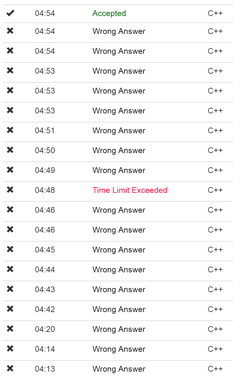Dirt Ratio
Time Limit: 18000/9000 MS (Java/Others) Memory Limit: 524288/524288 K (Java/Others)Total Submission(s): 1104 Accepted Submission(s): 486
Special Judge
Problem Description
In ACM/ICPC contest, the ''Dirt Ratio'' of a team is calculated in the following way. First let's ignore all the problems the team didn't pass, assume the team passed
X
problems during the contest, and submitted
Y
times for these problems, then the ''Dirt Ratio'' is measured as
XY
. If the ''Dirt Ratio'' of a team is too low, the team tends to cause more penalty, which is not a good performance.

Picture from MyICPC
Little Q is a coach, he is now staring at the submission list of a team. You can assume all the problems occurred in the list was solved by the team during the contest. Little Q calculated the team's low ''Dirt Ratio'', felt very angry. He wants to have a talk with them. To make the problem more serious, he wants to choose a continuous subsequence of the list, and then calculate the ''Dirt Ratio'' just based on that subsequence.
Please write a program to find such subsequence having the lowest ''Dirt Ratio''.

Picture from MyICPC
Little Q is a coach, he is now staring at the submission list of a team. You can assume all the problems occurred in the list was solved by the team during the contest. Little Q calculated the team's low ''Dirt Ratio'', felt very angry. He wants to have a talk with them. To make the problem more serious, he wants to choose a continuous subsequence of the list, and then calculate the ''Dirt Ratio'' just based on that subsequence.
Please write a program to find such subsequence having the lowest ''Dirt Ratio''.
Input
The first line of the input contains an integer
T(1≤T≤15)
, denoting the number of test cases.
In each test case, there is an integer n(1≤n≤60000) in the first line, denoting the length of the submission list.
In the next line, there are n positive integers a1,a2,...,an(1≤ai≤n) , denoting the problem ID of each submission.
In each test case, there is an integer n(1≤n≤60000) in the first line, denoting the length of the submission list.
In the next line, there are n positive integers a1,a2,...,an(1≤ai≤n) , denoting the problem ID of each submission.
Output
For each test case, print a single line containing a floating number, denoting the lowest ''Dirt Ratio''. The answer must be printed with an absolute error not greater than
10−4
.
Sample Input
1 5 1 2 1 2 3
Sample Output
0.5000000000HintFor every problem, you can assume its final submission is accepted.
Source
Recommend
题意:给n个数,设x/y为区间内不同数的个数除以区间长度,问x/y的最小值。
题解:二分答案x/y,当我们去检验mid的时候,会得到如下表达式(size表示区间不同数的个数)
之后我们对表达式进行转换
这样我们就可以根据如上表达式判断mid是否合法。我们每次枚举右端点,当新加入一个点的时候,我们需要对不包含这个数的最右的连续区间进行整体加1,这时候我们就可以,用线段树来维护区间最小值,线段树上的每一个叶子节点表示,size(l,r)+mid*l 。
#include <iostream>
#include <algorithm>
#include <cstdio>
#include <cmath>
#include <cstring>
#include <string>
#include <string.h>
#include <map>
#include <set>
#include <queue>
#include <deque>
#include <list>
#include <bitset>
#include <stack>
#include <stdlib.h>
#define lowbit(x) (x&-x)
#define e exp(1.0)
#define eps 1e-8
//ios::sync_with_stdio(false);
// auto start = clock();
// cout << (clock() - start) / (double)CLOCKS_PER_SEC;
typedef long long ll;
typedef long long LL;
using namespace std;
//维护size(l,r)+mid*l<=mid*(r+1)
const int maxn=60006;
double tree[maxn<<2],add[maxn<<2];
int last[maxn];
int a[maxn];
void pushdown(int root)
{
tree[root<<1]+=add[root];
tree[root<<1|1]+=add[root];
add[root<<1]+=add[root];
add[root<<1|1]+=add[root];
add[root]=0;
}
void update(int l,int r,int L,int R,int root,double k)
{
if(l<=L && r>=R)
{
tree[root]+=k;
add[root]+=k;
return ;
}
if(add[root]>eps)
pushdown(root);
int mid=(L+R)/2;
if(r<=mid) update(l,r,L,mid,root<<1,k);
else if(l>mid) update(l,r,mid+1,R,root<<1|1,k);
else
{
update(l,mid,L,mid,root<<1,k);
update(mid+1,r,mid+1,R,root<<1|1,k);
}
tree[root]=min(tree[root<<1],tree[root<<1|1]);
}
double query(int l,int r,int L,int R,int root)
{
if(l<=L && r>=R) return tree[root];
if(add[root]>eps) pushdown(root);
int mid=(L+R)/2;
if(r<=mid)return query(l,r,L,mid,root<<1);
else if(l>mid)return query(l,r,mid+1,R,root<<1|1);
else return min(query(l,mid,L,mid,root<<1),query(mid+1,r,mid+1,R,root<<1|1));
tree[root]=min(tree[root<<1],tree[root<<1|1]);
}
int main()
{
int T;
cin>>T;
while(T--)
{
int n;
cin>>n;
for(int i=1;i<=n;i++)
scanf("%d",&a[i]);
double l=0,r=1;
for(int bin=0;bin<20;bin++)
{
double mid=(l+r)/2.0;
memset(tree,0,sizeof(tree));
memset(add,0,sizeof(add));
memset(last,0,sizeof(last));
int flag=0;
for(int i=1;i<=n;i++)
{
update(last[a[i]]+1,i,1,n,1,1);
update(i,i,1,n,1,mid*i);
last[a[i]]=i;
double k=query(1,i,1,n,1);
if(k<=(double)mid*(i+1))
{
flag=1;
break;
}
}
if(!flag) l=mid;
else r=mid;
}
printf("%.4f\n",r);
}
return 0;
}







 本文探讨了在ACM/ICPC比赛中评估团队表现的一种特殊指标——DirtRatio,并提出了一种通过二分查找和线段树数据结构来确定最优子序列的方法。
本文探讨了在ACM/ICPC比赛中评估团队表现的一种特殊指标——DirtRatio,并提出了一种通过二分查找和线段树数据结构来确定最优子序列的方法。



















 被折叠的 条评论
为什么被折叠?
被折叠的 条评论
为什么被折叠?








